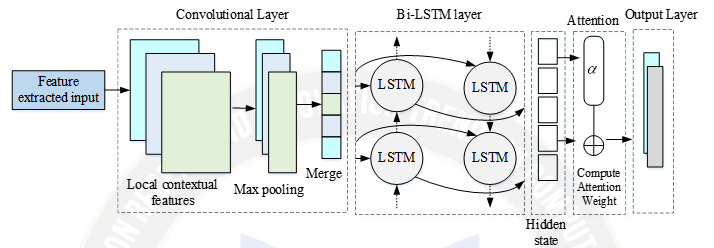Optimized Ensemble Approach for Multi-model Event Detection in Big data
Main Article Content
Abstract
Event detection acts an important role among modern society and it is a popular computer process that permits to detect the events automatically. Big data is more useful for the event detection due to large size of data. Multimodal event detection is utilized for the detection of events using heterogeneous types of data. This work aims to perform for classification of diverse events using Optimized Ensemble learning approach. The Multi-modal event data including text, image and audio are sent to the user devices from cloud or server where three models are generated for processing audio, text and image. At first, the text, image and audio data is processed separately. The process of creating a text model includes pre-processing using Imputation of missing values and data normalization. Then the textual feature extraction using integrated N-gram approach. The Generation of text model using Convolutional two directional LSTM (2DCon_LSTM). The steps involved in image model generation are pre-processing using Min-Max Gaussian filtering (MMGF). Image feature extraction using VGG-16 network model and generation of image model using Tweaked auto encoder (TAE) model. The steps involved in audio model generation are pre-processing using Discrete wavelet transform (DWT). Then the audio feature extraction using Hilbert Huang transform (HHT) and Generation of audio model using Attention based convolutional capsule network (Attn_CCNet). The features obtained by the generated models of text, image and audio are fused together by feature ensemble approach. From the fused feature vector, the optimal features are trained through improved battle royal optimization (IBRO) algorithm. A deep learning model called Convolutional duo Gated recurrent unit with auto encoder (C-Duo GRU_AE) is used as a classifier. Finally, different types of events are classified where the global model are then sent to the user devices with high security and offers better decision making process. The proposed methodology achieves better performances are Accuracy (99.93%), F1-score (99.91%), precision (99.93%), Recall (99.93%), processing time (17seconds) and training time (0.05seconds). Performance analysis exceeds several comparable methodologies in precision, recall, accuracy, F1 score, training time, and processing time. This designates that the proposed methodology achieves improved performance than the compared schemes. In addition, the proposed scheme detects the multi-modal events accurately.
Article Details
References
S. Wang, G. Yu, Z. Cai, X. Liu, E. Zhu, J. Yin et alVideo Abnormal Event Detection by Learning to Complete Visual Cloze Tests”, 2021, arXiv preprint arXiv:2108.02356.
A. Hodorog, I. Petri, Y. Rezgui, “Machine learning and Natural Language Processing of social media data for event detection in smart cities”. Sustainable Cities and Society, pp. 104026, vol. 85, 2022.
Y. Zhang, C. Ridings, A. Semenov, “What to post? Understanding engagement cultivation in microblogging with big data-driven theory building”. International Journal of Information Management, vol. 102509, 2022.
M. M??yk, M. Chamarczuk, M. Malinowski, “Automatic image-based event detection for large-N seismic arrays using a convolutional neural network”. Remote Sensing, pp. 389, vol. 13, no. 3, 2021.
E.A. Hinojosa-Palafox, OM Rodríguez-Elías, JA,Hoyo-Montaño JH Pacheco-Ramírez, JM Nieto-Jalil. “An analytics environment architecture for industrial cyber-physical systems big data solutions”. Sensors, pp. 4282, vol. 21, no. 13, 2021.
Y. Cao, H. Peng, J. Wu, Y. Dou, J. Li, P.S. Yu, “Knowledge-preserving incremental social event detection via heterogeneous gnns”. In Proceedings of the Web Conference pp. 3383-3395, vol. 2021, 2021, April.
A. Hodorog, I. Petri, Y. Rezgui, “Machine learning and Natural Language Processing of social media data for event detection in smart cities”. Sustainable Cities and Society, pp. 104026, vol. 85, 2022.
Y. Chen, Y. Li, Z. Wang, A.J. Quintero, C. Yang, W. Ji, “Rapid perception of public opinion in emergency events through social media”. Nat. Hazards Rev, pp. 04021066, vol. 23, no. 2, 2022.
F. Agneessens, G.J. Labianca, “Collecting survey-based social network information in work organizations”. Social Networks, pp. 31-47, vol. 68, 2022.
Y. Wu, H. Huang, N. Wu, Y. Wang, M.Z. Bhuiyan, T. Wang, “An incentive-based protection and recovery strategy for secure big data in social networks”. Information Sciences, pp. 79-91, vol. 508, 2020.
Morzelona, R. (2021). Human Visual System Quality Assessment in The Images Using the IQA Model Integrated with Automated Machine Learning Model . Machine Learning Applications in Engineering Education and Management, 1(1), 13–18. Retrieved from http://yashikajournals.com/index.php/mlaeem/article/view/5
H.U. Khan, S. Nasir, K. Nasim, D. Shabbir, A. Mahmood, “Twitter trends: A ranking algorithm analysis on real time data”. Expert Systems with Applications, pp. 113990, vol. 164, 2021.
M. Paul, M. Danelljan, L. Van Gool, R. Timofte, “Local memory attention for fast video semantic segmentation”. In 2021 IEEE/RSJ International Conference on Intelligent Robots and Systems (IROS) pp. 1102-1109, 2021, January.
Z Wu, W Wang, Y Peng “Deep learning-based UAV detection in the low altitude clutter background”, 2022. arXiv preprint arXiv:2202.12053.
E. Curry, D. Salwala, P. Dhingra, F.A. Pontes, P. Yadav, “Multimodal event processing: A neural-symbolic paradigm for the internet of multimedia things”. IEEE Internet of Things Journal 2022.
S. Hussain, M. Mubeen, A. Ahmad, S. Fahad, W. Nasim, H.M. Hammad, G.M. Shah, B. Murtaza, M. Tahir, S. Parveen, “Using space–time scan statistic for studying the effects of COVID-19 in Punjab, Pakistan: A guideline for policy measures in regional agriculture”. Environmental Science and Pollution Research, pp. 1-14, 2021.
C. Choi, S.Y. Hong, “MDST-DBSCAN: A Density-Based Clustering Method for Multidimensional Spatiotemporal Data”. ISPRS International Journal of Geo-Information, pp. 391, vol. 10, no. 6, 2021.
M. Elbadawi, S. Gaisford, A.W. Basit, “Advanced machine-learning techniques in drug discovery”. Drug Discovery Today, vol. 26, no. 3, 2021, pp. 769-777.
Vyas, A. ., & Sharma, D. A. . (2020). Deep Learning-Based Mango Leaf Detection by Pre-Processing and Segmentation Techniques. Research Journal of Computer Systems and Engineering, 1(1), 11–16. Retrieved from https://technicaljournals.org/RJCSE/index.php/journal/article/view/18
N.S. Nafis, S. Awang, “An enhanced hybrid feature selection technique using term frequency-inverse document frequency and support vector machine-recursive feature elimination for sentiment classification”. IEEE Access, pp. 52177-52192, vol. 9, 2021.
Z. Huo, W. Zhu, P. Pei, “Network Traffic Statistics Method for Resource-Constrained Industrial Project Group Scheduling under Big Data”. Wireless Communications and Mobile Computing, vol. 2021, 2021.
Z. Ahmad, A. S. Khan, C. W. Shiang, J. Abdullah, F. Ahmad, “Network intrusion detection system: A systematic study of machine learning and deep learning approaches”. Transactions on Emerging Telecommunications Technologies, pp. e4150, vol. 32, no. 1, 2021. 21. E. Alomari, I. Katib, Aiiad Albeshri, Tan Yigitcanlar, and Rashid Mehmood, “Iktishaf+: a big data tool with automatic labeling for road traffic social sensing and event detection using distributed machine learning”. Sensors, pp. 2993, vol. 21, no. 9, 2021.
K. Alfalqi, M. Bellaiche, “An Emergency Event Detection Ensemble Model Based on Big Data”. Big Data and Cognitive Computing, pp. 42, vol. 6, no. 2, 2022.
E. Alomari, I. Katib, R. Mehmood, “Iktishaf: A big data road-traffic event detection tool using Twitter and spark machin learning”. Mobile Networks and Applications, pp. 1-16, 2020.
Y. George, S. Karunasekera, A. Harwood, K. H. Lim, “Real-time spatio-temporal event detection on geotagged social media”. Journal of Big Data, pp. 1-28, vol. 8, no. 1, 2021.
H. M. Lee, S.J. Lee, “A Study on Security Event Detection in ESM Using Big Data and Deep Learning”. International Journal of Internet, Broadcasting and Communication, pp. 42-49, vol. 13, no. 3, 2021.
K. Alfalqi, M. Bellaiche, "An Emergency Event Detection Ensemble Model Based on Big Data." Big Data and Cognitive Computing pp. 42, vol. 6, no. 2, 2022.
A. D. Smith, "Event detection in educational records: an application of big data approaches." International Journal of Business and Systems Research pp. 271-291, vol. 15, no. 3, 2021.
Mr. Ather Parvez Abdul Khalil. (2012). Healthcare System through Wireless Body Area Networks (WBAN) using Telosb Motes. International Journal of New Practices in Management and Engineering, 1(02), 01 - 07. Retrieved from http://ijnpme.org/index.php/IJNPME/article/view/4
Z. Yang, Z. Lin, L. Guo, Q. Li, W. Liu, "MMED: a multi-domain and multi-modality event dataset." Information Processing & Management pp. 102315, vol. 57, no. 6, 2020.
Brown, R., Brown, J., Rodriguez, C., Garcia, J., & Herrera, J. Predictive Analytics for Effective Resource Allocation in Engineering Education. Kuwait Journal of Machine Learning, 1(1). Retrieved from http://kuwaitjournals.com/index.php/kjml/article/view/91
M. S. Mredula, N. Dey, M. S. Rahman, I. Mahmud, Y.Z. Cho, "A Review on the Trends in Event Detection by Analyzing Social Media Platforms’ Data." Sensors pp. 4531, vol. 22, no. 12, 2022.
Y. Liu, H. Peng, J. Li, Y. Song, X. Li, "Event detection and evolution in multi-lingual social streams." Frontiers of Computer Science pp. 1-15, vol. 14, 2020.
V. Pekar, J. Binner, H. Najafi, C. Hale, V. Schmidt, "Early detection of heterogeneous disaster events using social media." Journal of the Association for Information Science and Technology pp. 43-54, vol. 71, no. 1, 2020.
Ali, Daler, Malik Muhammad Saad Missen, and Mujtaba Husnain. "Multiclass event classification from text." Scientific Programming pp. 1-15, vol. 2021, 2021.
D. Choi, S. Park, D. Ham, H. Lim, K. Bok, J. Yoo, "Local event detection scheme by analyzing relevant documents in social networks." Applied Sciences pp. 577, vol. 11, no. 2, 2021.
R. Di Girolamo, C. Esposito, V. Moscato, G. Sperlí, "Evolutionary game theoretical on-line event detection over tweet streams." Knowledge-Based Systems pp. 106563, vol. 211, 2021.
L. Huang, G. Liu, T. Chen, H. Yuan, P. Shi, Y. Miao, "Similarity-based emergency event detection in social media." Journal of Safety Science and Resilience pp. 11-19, vol. 2, no. 1, 2021.
C. Shen, Z. Li, Y. Chu, Z. Zhao, "GAR: Graph adversarial representation for adverse drug event detection on Twitter." Applied Soft Computing pp. 107324, vol. 106, 2021.
K. Swapnika, D. Vasumathi, “Multimodal event detection in big data using multi-level fusion classifier”. Indian Journal of Computer Science and Engineering (IJCSE), pp. 796-811, vol. 13, no. 3, 2022.
L. l. Shi, L. Liu, Y. Wu, L. Jiang, A. Ayorinde, "Event detection and multi-source propagation for online social network management." Journal of Network and Systems Management pp. 1-20, vol. 28, 2020.
N. Dey, M. S. Rahman, M. S. Mredula, A.S.M. S. Hosen, I.-Ho Ra, "Using machine learning to detect events on the basis of Bengali and banglish Facebook posts." Electronics pp. 2367, vol. 10, no. 19, 2021.
C. Fan, F. Wu, A. Mostafavi, "A hybrid machine learning pipeline for automated mapping of events and locations from social media in disasters." IEEE Access pp. 10478-10490, vol. 8, 2020.
Solanki, S. ., Singh, U. P. ., Chouhan, S. S. ., & Jain, S. . (2023). Brain Tumour Detection and Classification by using Deep Learning Classifier. International Journal of Intelligent Systems and Applications in Engineering, 11(2s), 279 –. Retrieved from https://ijisae.org/index.php/IJISAE/article/view/2624
Wang Wei, Natural Language Processing Techniques for Sentiment Analysis in Social Media , Machine Learning Applications Conference Proceedings, Vol 1 2021.

